"We don't really have extremist groups here," he said. "This is the heart of the Bible belt."
--Lufkin (TX) Police Sgt. Stephen Abbott, quoted in the Austin American Statesman.
This remark was in regard to a guy from Lufkin named Paul Ross Evans, who was just arrested for planting a bomb at an Austin abortion clinic.
Monday, April 30, 2007
Sunday, April 29, 2007
The old Caldwell County Jail
My intention today was to take photos at a couple of old Mexican graveyards, but I ended up in taking pictures of an abandoned jail instead. (Notice that I avoided the cheap writerly temptation to say I ended up in jail. It's not often I have such discipline.) The old Caldwell County jail is in Lockhart, Texas, and was in use from about 1910 until 1982. It's a kind of jail you used to see in little towns all around Texas. They have mostly been torn down, and replaced with facilities no doubt just as inhumane, if not more so, but more comfortable for the staff and harder to break out of, allegedly.
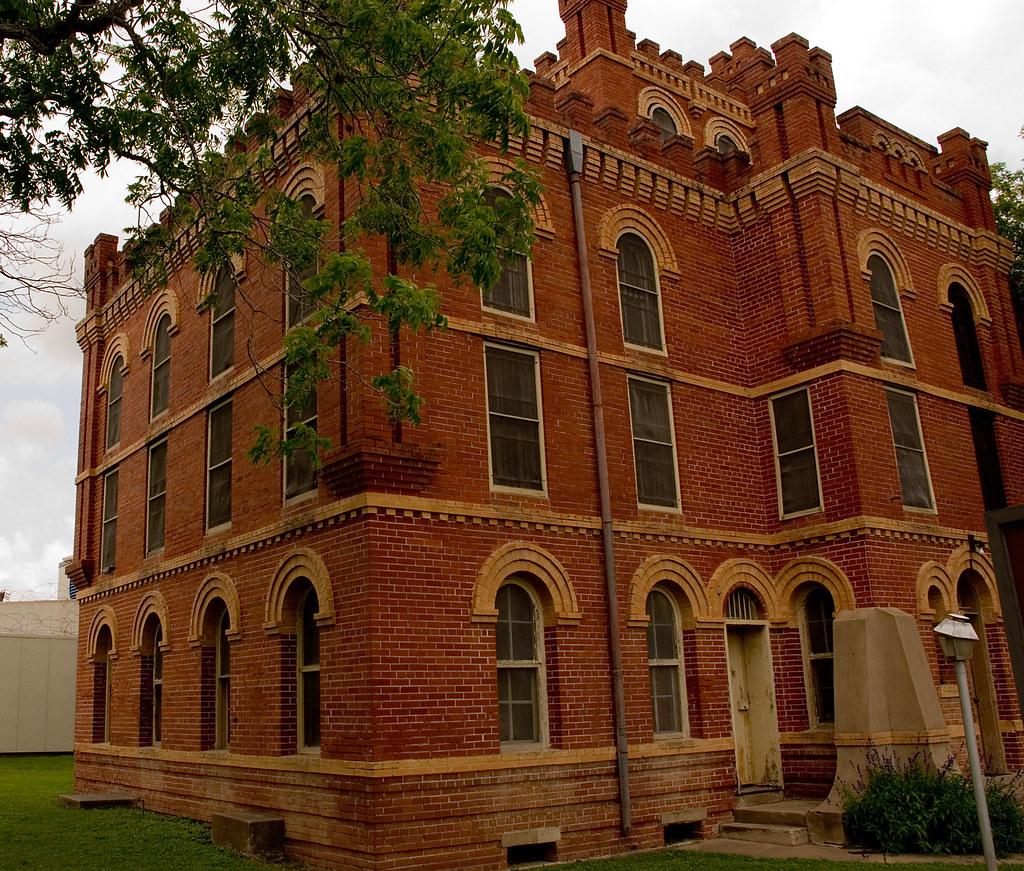
(All photos can be viewed larger on Flickr.)
This is actually a very small building. I didn't count the, um, beds, but I'd say the place could have held 15 to 20 very crowded prisoners at one time. The jailer and his family lived on the ground floor. The two floors above were where most of the prisoners were housed, and there was a place for a gallows in a stairwell space between these two floors. The gallows was removed in the 1930s without ever having been used, according to the woman who ran the museum now housed in the jail building. The fourth floor was a single room used for solitary confinement. It was actually a lot roomier and nicer than the other cells, and it had a view. For all the other cells, there was an observation corridor used by the jailer that stood between the cells and the windows so the prisoners could not really see out.
The museum is a local history museum with the excellent odds and ends that I have come to expect from local history societies--a sword from the Civil War that belonged to a local worthy, a saddle from the Chisholm Trail along with a gallery of portrait photos of Chisholm Trail cowboys, an Edison phonograph with a hand crank, someone's piano, a local doctor's turn of the (20th) century bedroom furniture, et cetera. I love stuff like that, and the museum proper--i.e., the ground floor jailer's quarters--was full of such things. But to my surprise, the public is allowed to go upstairs and through the old jail itself, which is pretty much unchanged since 1982, except dingier and the paint as now all peeling, and plus there is no bedding on the steel beds.
There was a photo in the museum of the first sheriff to run this jail, above a display case which held his brass knuckles. He was murdered walking over the railroad tracks between the courthouse, two blocks away, and the jailhouse. I speculated that the brass knuckles might have had something to do with the unsolved murder, but the museum lady seemed to think it was courthouse politics gone very severe.
In any case, you don't want to go to jail in Caldwell County. At least not then, and probably not now.
Photos follow:
Common room. What you see on the opposite wall is a sink, not a urinal. Both the second and third floors had very low headroom. It looks like they painted over graffiti with metallic paint every few years, but when the jail was abandoned they seem to have left the last wall-writings untouched.
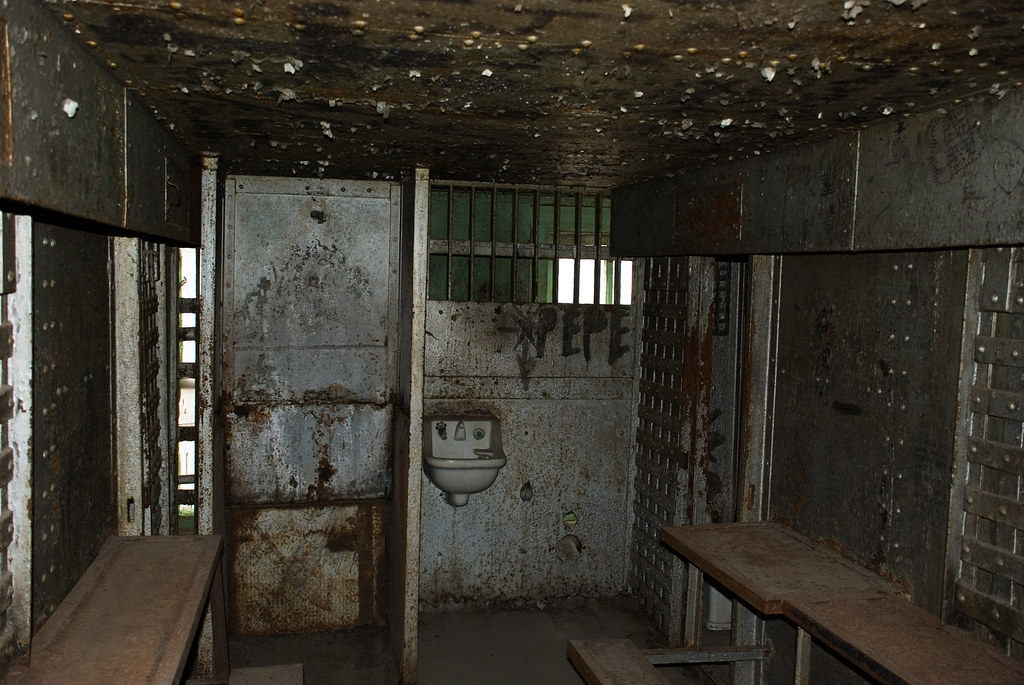
Beyond the door is a 2 person cell, about the size of a broom closet. There are two steel bunks in there. Some cells were bigger than others, leading me to remember that the jail was almost certainly racially segregated. I didn't ask the museum woman, but I suspect that the smaller cells were for racial minorities.

This is solitary, on the 4th floor. As I mentioned, it is more spacious than the other cells.
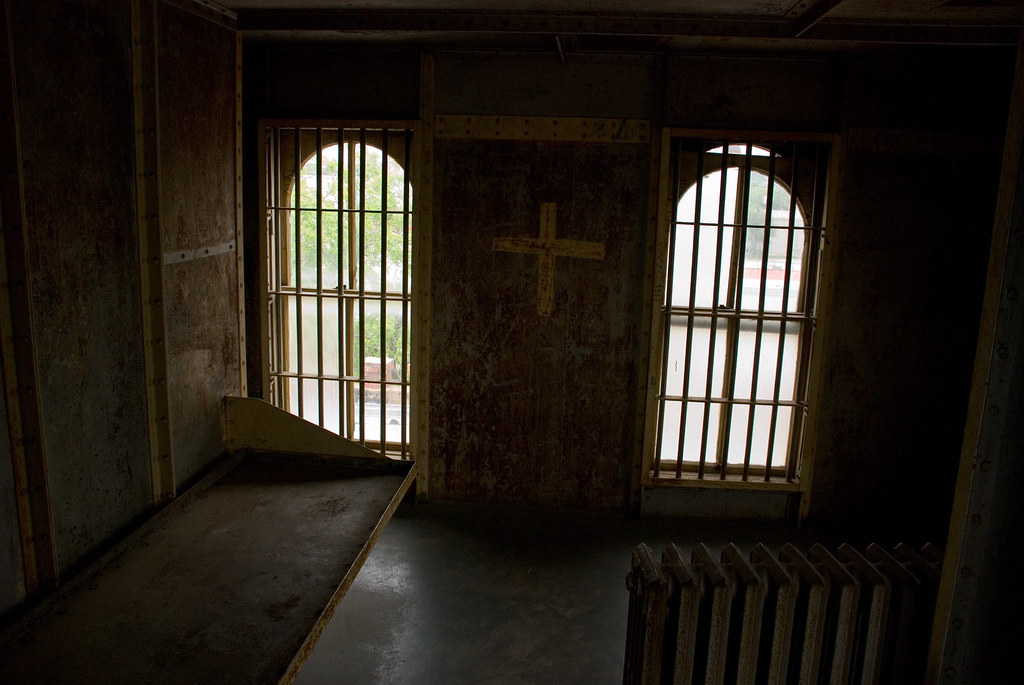
This is the view from solitary.
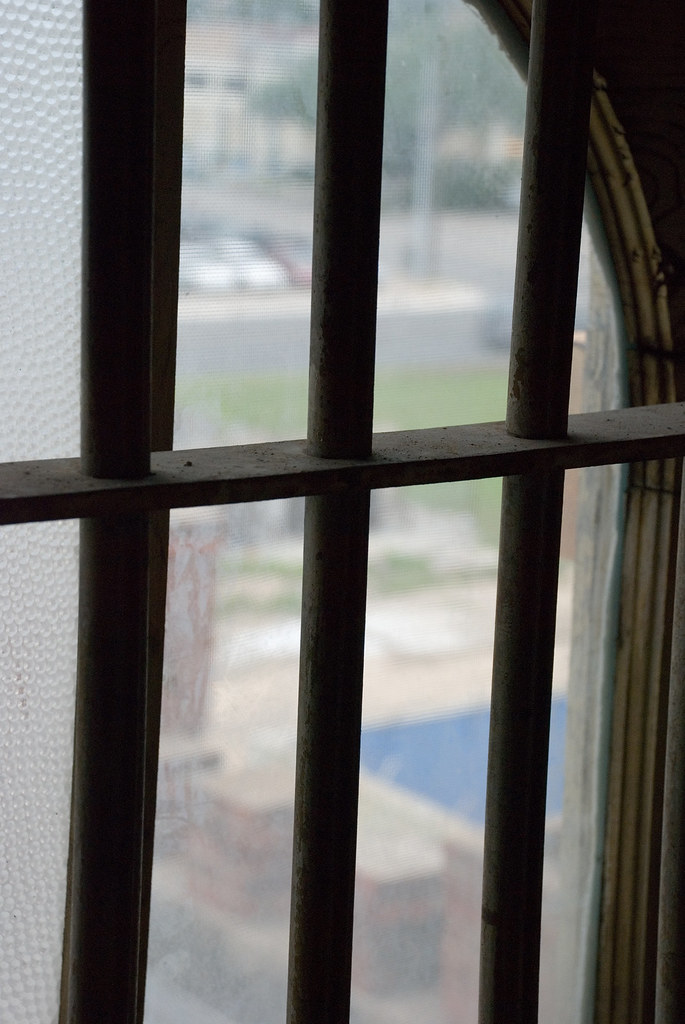
Jailhouse wisdom. This is actually not original to the graffitist--it's a quote from Bernard Meltzer, a radio show host from the 1960s through at least the 1980s. Maybe the jailer put it there for the comfort of the prisoners, though I doubt if jailers were encouraged to write on walls.
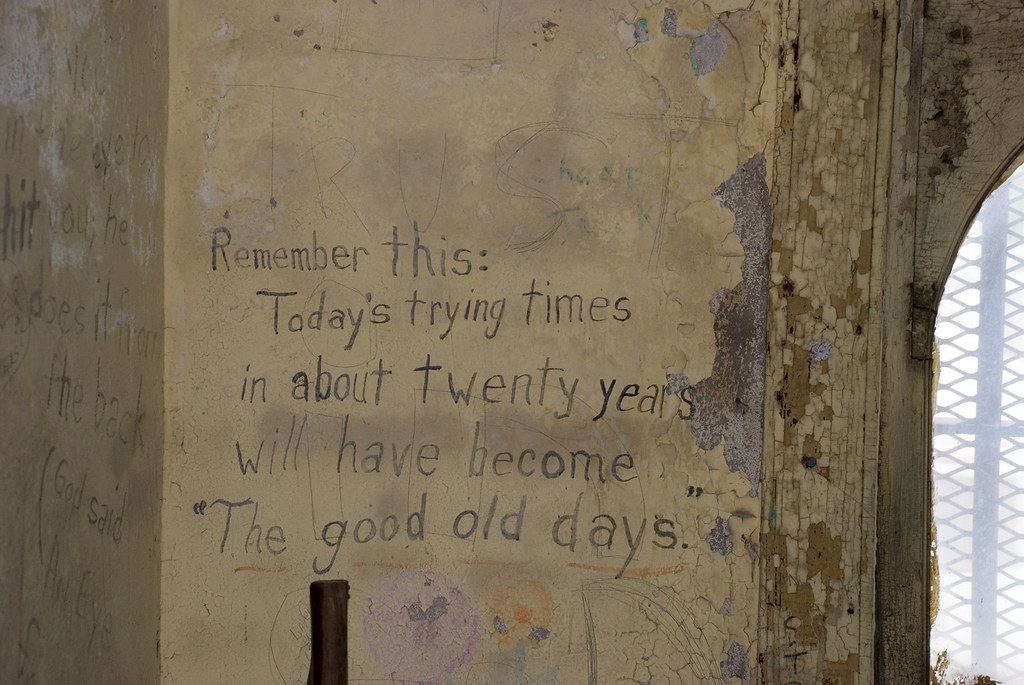
This graffito is more mysterious, but seems more authentic--as you can see it was first written in pencil and then recopied more legibly by the spider artist.

This cell contained "El Vato," which might be translated as anything from "The Dude" to "The Badass." El Vato may have been the same as person as "a la pinta Arturo Acosta." "A la pinta" would mean " on the way to the pen."
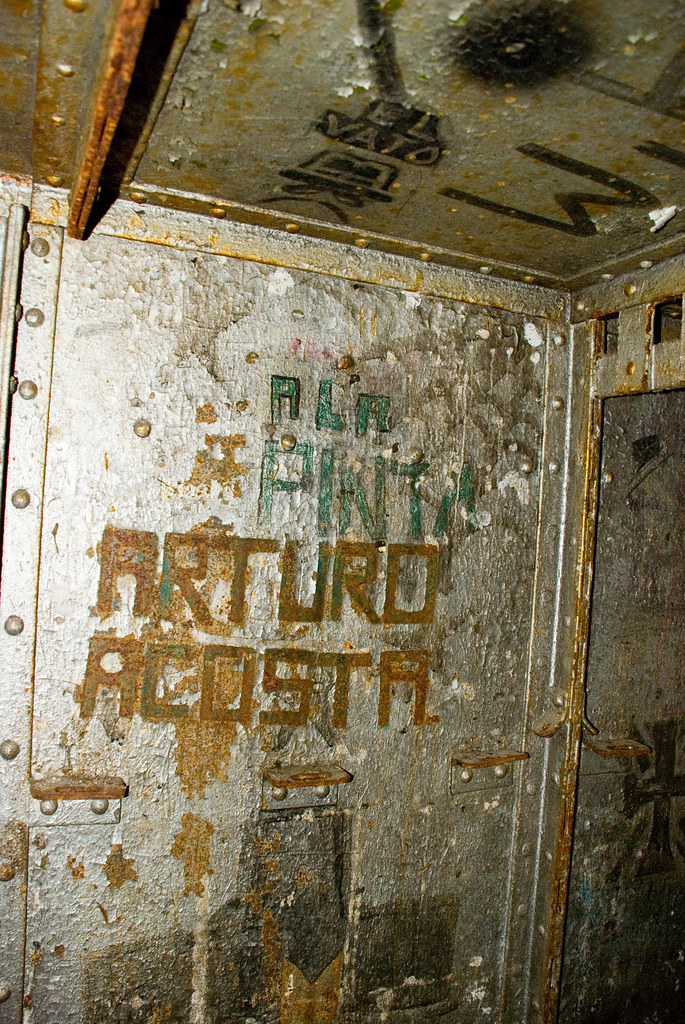
Finally, a jail corridor, for atmosphere.
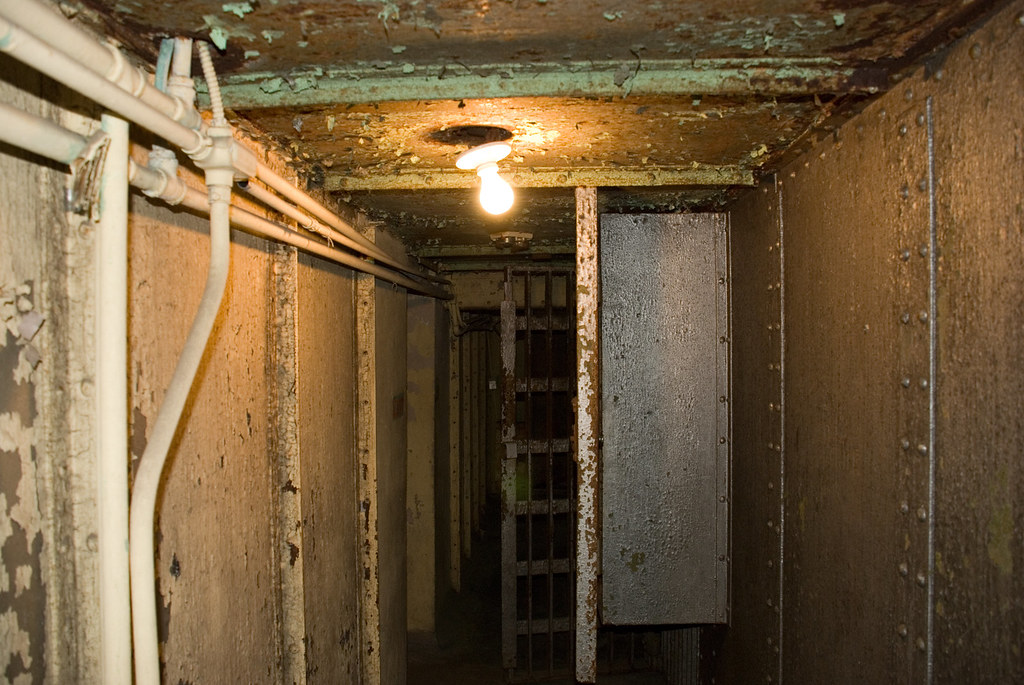

(All photos can be viewed larger on Flickr.)
This is actually a very small building. I didn't count the, um, beds, but I'd say the place could have held 15 to 20 very crowded prisoners at one time. The jailer and his family lived on the ground floor. The two floors above were where most of the prisoners were housed, and there was a place for a gallows in a stairwell space between these two floors. The gallows was removed in the 1930s without ever having been used, according to the woman who ran the museum now housed in the jail building. The fourth floor was a single room used for solitary confinement. It was actually a lot roomier and nicer than the other cells, and it had a view. For all the other cells, there was an observation corridor used by the jailer that stood between the cells and the windows so the prisoners could not really see out.
The museum is a local history museum with the excellent odds and ends that I have come to expect from local history societies--a sword from the Civil War that belonged to a local worthy, a saddle from the Chisholm Trail along with a gallery of portrait photos of Chisholm Trail cowboys, an Edison phonograph with a hand crank, someone's piano, a local doctor's turn of the (20th) century bedroom furniture, et cetera. I love stuff like that, and the museum proper--i.e., the ground floor jailer's quarters--was full of such things. But to my surprise, the public is allowed to go upstairs and through the old jail itself, which is pretty much unchanged since 1982, except dingier and the paint as now all peeling, and plus there is no bedding on the steel beds.
There was a photo in the museum of the first sheriff to run this jail, above a display case which held his brass knuckles. He was murdered walking over the railroad tracks between the courthouse, two blocks away, and the jailhouse. I speculated that the brass knuckles might have had something to do with the unsolved murder, but the museum lady seemed to think it was courthouse politics gone very severe.
In any case, you don't want to go to jail in Caldwell County. At least not then, and probably not now.
Photos follow:
Common room. What you see on the opposite wall is a sink, not a urinal. Both the second and third floors had very low headroom. It looks like they painted over graffiti with metallic paint every few years, but when the jail was abandoned they seem to have left the last wall-writings untouched.

Beyond the door is a 2 person cell, about the size of a broom closet. There are two steel bunks in there. Some cells were bigger than others, leading me to remember that the jail was almost certainly racially segregated. I didn't ask the museum woman, but I suspect that the smaller cells were for racial minorities.

This is solitary, on the 4th floor. As I mentioned, it is more spacious than the other cells.

This is the view from solitary.

Jailhouse wisdom. This is actually not original to the graffitist--it's a quote from Bernard Meltzer, a radio show host from the 1960s through at least the 1980s. Maybe the jailer put it there for the comfort of the prisoners, though I doubt if jailers were encouraged to write on walls.

This graffito is more mysterious, but seems more authentic--as you can see it was first written in pencil and then recopied more legibly by the spider artist.

This cell contained "El Vato," which might be translated as anything from "The Dude" to "The Badass." El Vato may have been the same as person as "a la pinta Arturo Acosta." "A la pinta" would mean " on the way to the pen."

Finally, a jail corridor, for atmosphere.

Tuesday, April 17, 2007
Remembering a mass murder
I was on the University of Texas campus on August 1, 1966, when Charlie Whitman started shooting people from the university tower. I had graduated from UT 2 years before, had lived in San Francisco after joining the Army reserves, and had just returned to Austin. I was unemployed, trying to decide whether to go back to San Francisco, and was hanging out in the student union (already a slacker.)
I heard banging noises which sounded like they were coming from the courtyard between the student union building and a library building. It was an odd sound, and for some bizarre reason my mind finally concluded it was someone cracking a whip there. Never mind that I had never in my time as a student seen anyone cracking a whip on the University of Texas campus, or anywhere else in Austin for that matter--it was somehow what I thought. And I thought nothing more about it for several minutes.
The whip cracking continued. I idly decided to see what was going on, and walked over to where I could see the courtyard. No whip cracker, but the noise continued. Someone came running down the student union hallway and said that a guy had been shot while riding a bicycle on the Drag, as the main street on the west side of the campus was called.
I heard somebody else say someone was shooting from the tower.
So, naturally, I went to the nearest window in the student union building where I could see the tower. I stood there in the middle of the window, along with several other people, and I could clearly see Whitman with his rifle. He was shooting over the tower parapet at that time. (Later, when police and deer-hunter citizens started shooting back, he began shooting from some port holes under the stone parapet.)
It should have occurred to me that if I could see Whitman clearly, he could see me clearly. But that thought did not enter my head. I decided to make room for others to gawk, and as I moved away from the window, Whitman shot someone who had been standing next to me. There was a big commotion, and all I could see was that someone fell down, people ran away from the window and they pulled the wounded person away. That wounded person lived.
Nobody stood in the window after that.
I didn't know any of the people killed, though one of them was the son of a professor I liked.
I was staying with a friend of mine who was a grad student in biology. He and his wife and I went to see a movie later that day, in the middle of the afternoon, a comedy, I think, though I remember nothing about it. I remember sitting in the dark in an old-fashioned downtown movie theater paying no attention to whatever was on the screen. Sitting in the dark for 2 hours watching a movie none of us paid any attention to seemed to make us all feel better.
The murders were very shocking to me--more so even than the one yesterday in Virginia, though probably that was because I happened to be present at the UT tower shooting. Still, I wonder if my impression that a crime like that was more unimaginable then than now, is true. That the mere fact that crimes like that are more imaginable, makes them more possible?
I heard banging noises which sounded like they were coming from the courtyard between the student union building and a library building. It was an odd sound, and for some bizarre reason my mind finally concluded it was someone cracking a whip there. Never mind that I had never in my time as a student seen anyone cracking a whip on the University of Texas campus, or anywhere else in Austin for that matter--it was somehow what I thought. And I thought nothing more about it for several minutes.
The whip cracking continued. I idly decided to see what was going on, and walked over to where I could see the courtyard. No whip cracker, but the noise continued. Someone came running down the student union hallway and said that a guy had been shot while riding a bicycle on the Drag, as the main street on the west side of the campus was called.
I heard somebody else say someone was shooting from the tower.
So, naturally, I went to the nearest window in the student union building where I could see the tower. I stood there in the middle of the window, along with several other people, and I could clearly see Whitman with his rifle. He was shooting over the tower parapet at that time. (Later, when police and deer-hunter citizens started shooting back, he began shooting from some port holes under the stone parapet.)
It should have occurred to me that if I could see Whitman clearly, he could see me clearly. But that thought did not enter my head. I decided to make room for others to gawk, and as I moved away from the window, Whitman shot someone who had been standing next to me. There was a big commotion, and all I could see was that someone fell down, people ran away from the window and they pulled the wounded person away. That wounded person lived.
Nobody stood in the window after that.
I didn't know any of the people killed, though one of them was the son of a professor I liked.
I was staying with a friend of mine who was a grad student in biology. He and his wife and I went to see a movie later that day, in the middle of the afternoon, a comedy, I think, though I remember nothing about it. I remember sitting in the dark in an old-fashioned downtown movie theater paying no attention to whatever was on the screen. Sitting in the dark for 2 hours watching a movie none of us paid any attention to seemed to make us all feel better.
The murders were very shocking to me--more so even than the one yesterday in Virginia, though probably that was because I happened to be present at the UT tower shooting. Still, I wonder if my impression that a crime like that was more unimaginable then than now, is true. That the mere fact that crimes like that are more imaginable, makes them more possible?
Saturday, April 14, 2007
Low-impact crusade
Over at Meanwhile Back at the Ranch Idyllopus is (gently) criticizing No Impact Man, whose blog which consists in a running journal of a low impact Manhattan lifestyle. As a Zen guy, I like paradoxes like the juxtaposition of "low-impact" and "Manhattan." Plus as a bonus (for me) no impact man currently has a somewhat bizarre discussion of Nansen's cat, an infamous koan. (Technical detail: NIM uses the Korean spelling of Nansen, I use the more common Japanese spelling. In present-day Pinyin it would be Nanquan.) NIM seems to think that the cat is the planet. It's unclear to me whether NIM considers that he is the Zen maniac who, as a test of the monks (metaphorically, one presumes) kills the cat, or that his critics are the killers, or both. That's very Zen.
I don't have any criticism of a low-impact lifestyle. I am pretty low impact myself, but it's a function of being Low-Income Man, plus maybe some remote Scottish stinginess inherited from my forebears, operating scarcely diminished at a remove of 300 years.
It seems to me very American of us to make saving the planet into a personal and moral quest, like NIM does. America, in our minds, should still be a City on a Hill, a new Jerusalem (never mind that the reality of America, from the beginnings till now, ought to disabuse us of such notions.) And if we are gonna be worthy of being among the elect, we must be strenuous in the pursuit of personal goodness. Who can object to that? I certainly don't. I like good people, and the low-impact crusaders are good people, by and large. As an old hippie, I have personal memories of earlier such children's crusades. I was a part of them. I still cherish the worldview we had. I am not cynical about the motives of the children. They may have been the finest children in the world.
The problem is that it won't save the planet.
The tragedy of the commons works on all scales, from an individual to an international level. Personally and locally, if I use less gasoline, it increases the supply, and lowers the price to Hummer owners, who drive more. Internationally, if the US as a nation decreases gasoline consumption, it increases gasoline availability for others, which leads to a decrease in the price of gasoline in, say, China, where in response they build more cars and highways, and drive more.
Likewise, Jevons's paradox is a related problem. William Stanley Jevons first noticed that the increased efficiency of Watt's steam engine over the earlier Newcomen engine led to more coal being burned, not less. It's intuitively obvious to us why this is so, but it was a puzzle to economists. Increased fuel efficiency of cars will not, of itself, lead to less gasoline being consumed, but will very possibly have the opposite result.
The only way to get circumvent these two tendencies is through governmental action (gas taxes, rationing, etc.) and, on a larger scale, international treaties. This requires a sense of emergency, like everyone had in world war II. We do not yet have such a sense of emergency. But, because the problem is genuine, we will presumably realize the emergency exists at some point, and be willing to act. The question is, of course, will it be too late. I wish I knew the answer.
(I was going to put in a coda that came out basically sounding like "in the meantime, to thine own self be true." But one of the reasons I have cut back on political blogging is the Polonius quality it had--to my mind at least. I laughed the other day when I read, in James Wolcott I think, a quote from someone else to the effect that what we really love about Hamlet is that Polonius gets stabbed. So, in the spirit of Nansen, I will now try to kill off Polonius for a few days again.)
Addendum: In the original version of this post, I had overlooked a certain grandiosity of NIM's blogname, and mistakenly referred to the blog's author as Low Impact Man. Sorry for the carelessness.
Arbitrary Zen photo

I don't have any criticism of a low-impact lifestyle. I am pretty low impact myself, but it's a function of being Low-Income Man, plus maybe some remote Scottish stinginess inherited from my forebears, operating scarcely diminished at a remove of 300 years.
It seems to me very American of us to make saving the planet into a personal and moral quest, like NIM does. America, in our minds, should still be a City on a Hill, a new Jerusalem (never mind that the reality of America, from the beginnings till now, ought to disabuse us of such notions.) And if we are gonna be worthy of being among the elect, we must be strenuous in the pursuit of personal goodness. Who can object to that? I certainly don't. I like good people, and the low-impact crusaders are good people, by and large. As an old hippie, I have personal memories of earlier such children's crusades. I was a part of them. I still cherish the worldview we had. I am not cynical about the motives of the children. They may have been the finest children in the world.
The problem is that it won't save the planet.
The tragedy of the commons works on all scales, from an individual to an international level. Personally and locally, if I use less gasoline, it increases the supply, and lowers the price to Hummer owners, who drive more. Internationally, if the US as a nation decreases gasoline consumption, it increases gasoline availability for others, which leads to a decrease in the price of gasoline in, say, China, where in response they build more cars and highways, and drive more.
Likewise, Jevons's paradox is a related problem. William Stanley Jevons first noticed that the increased efficiency of Watt's steam engine over the earlier Newcomen engine led to more coal being burned, not less. It's intuitively obvious to us why this is so, but it was a puzzle to economists. Increased fuel efficiency of cars will not, of itself, lead to less gasoline being consumed, but will very possibly have the opposite result.
The only way to get circumvent these two tendencies is through governmental action (gas taxes, rationing, etc.) and, on a larger scale, international treaties. This requires a sense of emergency, like everyone had in world war II. We do not yet have such a sense of emergency. But, because the problem is genuine, we will presumably realize the emergency exists at some point, and be willing to act. The question is, of course, will it be too late. I wish I knew the answer.
(I was going to put in a coda that came out basically sounding like "in the meantime, to thine own self be true." But one of the reasons I have cut back on political blogging is the Polonius quality it had--to my mind at least. I laughed the other day when I read, in James Wolcott I think, a quote from someone else to the effect that what we really love about Hamlet is that Polonius gets stabbed. So, in the spirit of Nansen, I will now try to kill off Polonius for a few days again.)
Addendum: In the original version of this post, I had overlooked a certain grandiosity of NIM's blogname, and mistakenly referred to the blog's author as Low Impact Man. Sorry for the carelessness.
Arbitrary Zen photo

Subscribe to:
Posts (Atom)